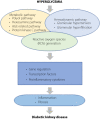Current status of diabetic kidney disease and latest trends in management
- PMID: 36001045
- PMCID: PMC9720214
- DOI: 10.1111/jdi.13895
Current status of diabetic kidney disease and latest trends in management
Abstract
Diabetic kidney disease (DKD) is one of the major microvascular complications of diabetes and is leading cause of end-stage renal disease (ESRD) and one of major risk factors of cardiovascular disease (CVD).
© 2022 The Authors. Journal of Diabetes Investigation published by Asian Association for the Study of Diabetes (AASD) and John Wiley & Sons Australia, Ltd.
Figures

Similar articles
-
Cardiovascular risk in diabetic end-stage renal disease patients.J Diabetes. 2011 Jun;3(2):119-31. doi: 10.1111/j.1753-0407.2011.00113.x. J Diabetes. 2011. PMID: 21599866 Review.
-
Diabetic Nephropathy: An Overview.Methods Mol Biol. 2020;2067:3-7. doi: 10.1007/978-1-4939-9841-8_1. Methods Mol Biol. 2020. PMID: 31701441
-
Gut microbiota and its metabolites - molecular mechanisms and management strategies in diabetic kidney disease.Front Immunol. 2023 Jan 19;14:1124704. doi: 10.3389/fimmu.2023.1124704. eCollection 2023. Front Immunol. 2023. PMID: 36742307 Free PMC article. Review.
-
Chronic Inflammation and Progression of Diabetic Kidney Disease.Contrib Nephrol. 2019;198:33-39. doi: 10.1159/000496526. Epub 2019 Apr 16. Contrib Nephrol. 2019. PMID: 30991405
-
Development and internal validation of machine learning algorithms for end-stage renal disease risk prediction model of people with type 2 diabetes mellitus and diabetic kidney disease.Ren Fail. 2022 Dec;44(1):562-570. doi: 10.1080/0886022X.2022.2056053. Ren Fail. 2022. PMID: 35373711 Free PMC article.
Cited by
-
Machine learning-based prediction of tubulointerstitial lesions in diabetic kidney disease: a multicenter validation study.Ren Fail. 2025 Dec;47(1):2547266. doi: 10.1080/0886022X.2025.2547266. Epub 2025 Aug 21. Ren Fail. 2025. PMID: 40841991 Free PMC article.
-
Influence of the combination of SGLT2 inhibitors and GLP-1 receptor agonists on eGFR decline in type 2 diabetes: post-hoc analysis of RECAP study.Front Pharmacol. 2024 Mar 27;15:1358573. doi: 10.3389/fphar.2024.1358573. eCollection 2024. Front Pharmacol. 2024. PMID: 38601470 Free PMC article.
-
Molecular Targets of Novel Therapeutics for Diabetic Kidney Disease: A New Era of Nephroprotection.Int J Mol Sci. 2024 Apr 3;25(7):3969. doi: 10.3390/ijms25073969. Int J Mol Sci. 2024. PMID: 38612779 Free PMC article. Review.
-
The Role of NF-κB and Bax/Bcl-2/Caspase-3 Signaling Pathways in the Protective Effects of Sacubitril/Valsartan (Entresto) against HFD/STZ-Induced Diabetic Kidney Disease.Biomedicines. 2022 Nov 9;10(11):2863. doi: 10.3390/biomedicines10112863. Biomedicines. 2022. PMID: 36359384 Free PMC article.
-
Causal impact of elevated body mass index on diabetic kidney disease: an integrated Mendelian randomization and Global Burden of Disease Study 2021 analysis.Ren Fail. 2025 Dec;47(1):2472981. doi: 10.1080/0886022X.2025.2472981. Epub 2025 Mar 17. Ren Fail. 2025. PMID: 40091641 Free PMC article.
References
-
- Sugahara M, Pak WLW, Tanaka T, et al. Update on diagnosis, pathophysiology, and management of diabetic kidney disease. Nephrology (Carlton) 2021; 26: 491–500. - PubMed
MeSH terms
LinkOut - more resources
Full Text Sources
Medical

